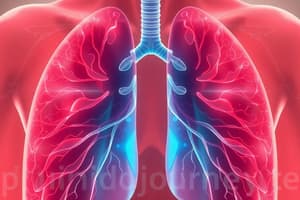Podcast
Questions and Answers
What is the primary function of the stomach in the human body?
What is the primary function of the stomach in the human body?
- To filter toxins from the blood
- To break down food into chyme (correct)
- To produce insulin for blood sugar regulation
- To store excess bile produced by the liver
Which of the following is a function of the liver in the human body?
Which of the following is a function of the liver in the human body?
- Filtering oxygen from the air we breathe
- Regulating blood sugar levels by releasing insulin
- Producing bile to aid in digestion (correct)
- Controlling body temperature by producing sweat
In the absorption process, where does most of the nutrients get absorbed in the digestive system?
In the absorption process, where does most of the nutrients get absorbed in the digestive system?
- Stomach
- Small intestine (correct)
- Large intestine
- Pancreas
What is a major function of the pancreas in the human body?
What is a major function of the pancreas in the human body?
Which of the following is a function of the lymphatic system in the human body?
Which of the following is a function of the lymphatic system in the human body?
Flashcards are hidden until you start studying
Study Notes
Respiratory System
- Alveoli are the air sacs of the lungs where gas exchange occurs
- Alveoli have thin walls made of simple cells and are surrounded by blood capillaries
- Oxygen diffuses into the blood and carbon dioxide diffuses into the alveoli through a layer of cells
- The surface of alveoli is covered in a thin lipoprotein layer that prevents them from collapsing during exhalation
Digestive System
- Purpose: to convert food particles into simpler micromolecules that can be absorbed into the bloodstream and used by the body
- Cell type: epithelial and muscle
- Major organs and their functions:
- Mouth: to chew and grind up food, begins the chemical breakdown
- Esophagus: pipe connecting mouth to stomach
- Stomach: secretes an extraordinarily strong acid (pH = 2) that leads to breakdown of food
- Pancreas: secretes digestive enzymes, produces the hormone insulin that regulates blood sugar levels
- Liver: produces bile that breaks down fats in foods
- Gallbladder: pouch-like organ that stores bile for future use
- Small Intestine: absorbs the chyme into the bloodstream
- Large Intestine: removes water from the chyme and gets the waste ready for excretion
Lymphatic/Immune System
- Purpose: to remove infectious diseases and other pathogens from the human body
- Cell type: Epithelial
- Major organs and their functions:
- Skin: also called the integumentary system, the skin is the body’s first line of defense
- White Blood Cells: recognize disease agents (antigens) and create antibodies to tag and remove these antigens
- Lymph Nodes: help restore fluid lost by the blood and return it to the circulatory system
- Spleen: produces and stores white blood cells
- Thymus: site of white blood cell maturation
Integumentary System
- Purpose: temperature regulation, waste removal, sensory info, and protection
- Largest organ of the body = skin
- Cell type: epithelial
- Hair functions:
- Absorbs radiation from the sun that may be harmful
- Reduces loss of heat
- Filters out dust and dirt
- Shows gender
- Sensitive to movement
- Nail functions:
- Protects tips of fingers or toes
- Helps pick up small objects
- Enhances sensation of the finger by acting as a counterforce
- Scratching
Muscular System
- Purpose: works with the skeletal and nervous system to produce movement, also helps to circulate blood through the human body
- Cell type: fibrous
- Muscle contractions can be voluntary or involuntary
- Makes up to 40-50% of the body mass
- Types of muscles:
- Skeletal: attached to bones, voluntary control, multinucleated, striated
- Smooth: internal organs (except heart), one nucleus, nonstriated, involuntary control
- Cardiac: heart muscle, involuntary control
Reproductive System
- Produces, matures, nourishes, and stores gametes
- Cell type: epithelial
- Male reproductive system:
- Testes: produce and store gametes
- Epididymis: stores and matures gametes
- Vas deferens: transports gametes
- Prostate: secretes fluids that nourish gametes
- Seminal vesicle: produces seminal fluid
- Penis: delivers gametes
- Female reproductive system:
- Ovary: produces and stores gametes
- Fallopian tube: transports gametes
- Uterus: nurtures a developing fetus
- Endometrium: lining of the uterus
- Cervix: connects uterus to vagina
- Vagina: birth canal
Circulatory System
- Purpose: to deliver oxygenated blood to the various cells and organ systems in your body
- Cell type: Muscle
- Major organs and their functions:
- Heart: pumps deoxygenated blood into the lungs, where it gets oxygenated, returned to the heart, and then pumped out through the aorta to the rest of the body
- Arteries: transport oxygenated blood away from the heart
- Veins: transport deoxygenated blood back to the heart
- Blood: carries oxygen and nutrients to cells and carries waste products away from cells
Nervous System
- Purpose: to coordinate the body’s response to changes in its internal and external environment
- Cell type: Nerve
- Major organs and their functions:
- Brain: control center of the body, where all processes are relayed through
- Spinal Cord: sends instructions from the brain to the rest of the body and vice versa
- Nerves: conduct impulses to muscle cells throughout the body
Studying That Suits You
Use AI to generate personalized quizzes and flashcards to suit your learning preferences.




